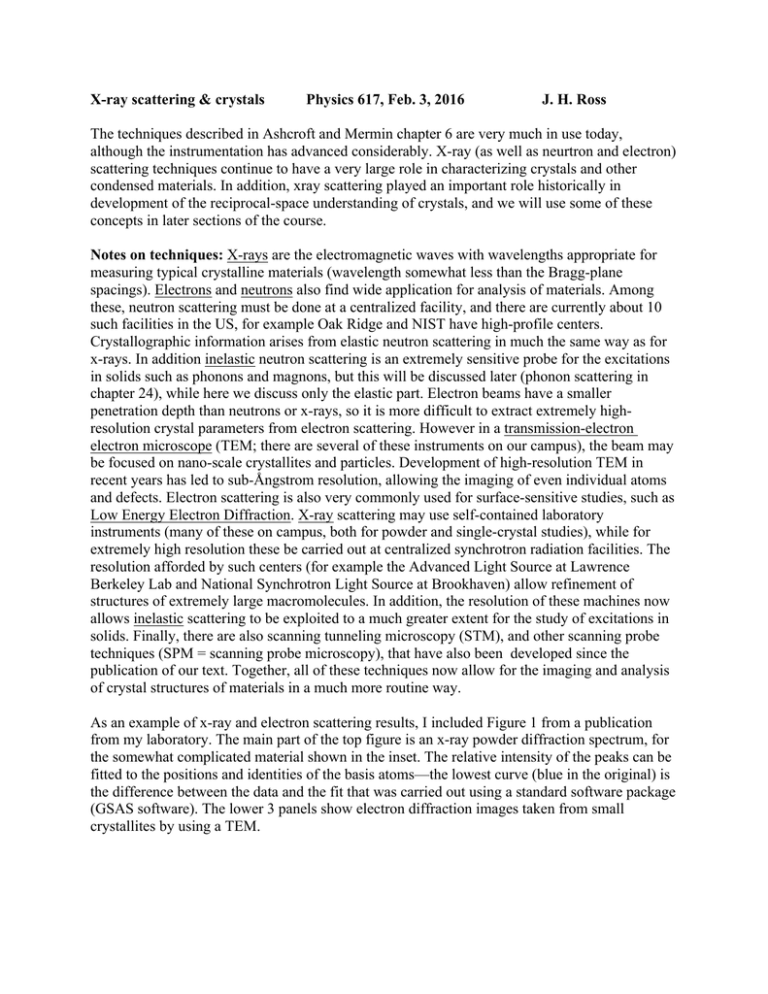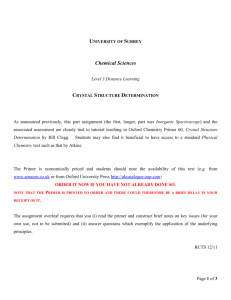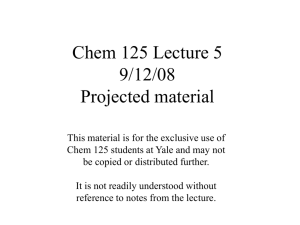X-ray scattering & crystals J. H. Ross
advertisement

X-ray scattering & crystals Physics 617, Feb. 3, 2016 J. H. Ross The techniques described in Ashcroft and Mermin chapter 6 are very much in use today, although the instrumentation has advanced considerably. X-ray (as well as neurtron and electron) scattering techniques continue to have a very large role in characterizing crystals and other condensed materials. In addition, xray scattering played an important role historically in development of the reciprocal-space understanding of crystals, and we will use some of these concepts in later sections of the course. Notes on techniques: X-rays are the electromagnetic waves with wavelengths appropriate for measuring typical crystalline materials (wavelength somewhat less than the Bragg-plane spacings). Electrons and neutrons also find wide application for analysis of materials. Among these, neutron scattering must be done at a centralized facility, and there are currently about 10 such facilities in the US, for example Oak Ridge and NIST have high-profile centers. Crystallographic information arises from elastic neutron scattering in much the same way as for x-rays. In addition inelastic neutron scattering is an extremely sensitive probe for the excitations in solids such as phonons and magnons, but this will be discussed later (phonon scattering in chapter 24), while here we discuss only the elastic part. Electron beams have a smaller penetration depth than neutrons or x-rays, so it is more difficult to extract extremely highresolution crystal parameters from electron scattering. However in a transmission-electron electron microscope (TEM; there are several of these instruments on our campus), the beam may be focused on nano-scale crystallites and particles. Development of high-resolution TEM in recent years has led to sub-Ångstrom resolution, allowing the imaging of even individual atoms and defects. Electron scattering is also very commonly used for surface-sensitive studies, such as Low Energy Electron Diffraction. X-ray scattering may use self-contained laboratory instruments (many of these on campus, both for powder and single-crystal studies), while for extremely high resolution these be carried out at centralized synchrotron radiation facilities. The resolution afforded by such centers (for example the Advanced Light Source at Lawrence Berkeley Lab and National Synchrotron Light Source at Brookhaven) allow refinement of structures of extremely large macromolecules. In addition, the resolution of these machines now allows inelastic scattering to be exploited to a much greater extent for the study of excitations in solids. Finally, there are also scanning tunneling microscopy (STM), and other scanning probe techniques (SPM = scanning probe microscopy), that have also been developed since the publication of our text. Together, all of these techniques now allow for the imaging and analysis of crystal structures of materials in a much more routine way. As an example of x-ray and electron scattering results, I included Figure 1 from a publication from my laboratory. The main part of the top figure is an x-ray powder diffraction spectrum, for the somewhat complicated material shown in the inset. The relative intensity of the peaks can be fitted to the positions and identities of the basis atoms—the lowest curve (blue in the original) is the difference between the data and the fit that was carried out using a standard software package (GSAS software). The lower 3 panels show electron diffraction images taken from small crystallites by using a TEM. Scattering from crystals: The concepts used in x-ray scattering include the Bragg formalism as well as that of von Laue, as described in your text. Von Laue’s original observation led to his being awarded the 1914 Nobel prize, while William H. and William L. Bragg played a major role in the development of this technique, leading to their being awarded the 1915 Nobel prize. The resulting set of techniques remains one of the most significant methods available for the study of crystal structures. The Bragg scattering law is: nλ = 2d sin θ . [1] This law is easily established by considering the crystal planes to be Figure 1. Upper figure: Powder x-ray diffraction spectrum, with “mirrors” scattering the x-ray fitted spectrum after structural refinement, for Ba8Si40Ga6 (shown in beam. Note that since the sin inset). Lower: Three electron diffraction scans for crystallites of the function cannot exceed 1, clearly λ same material, orientations indicated. Ref: Y. Li et al., Phys. Rev. B must be smaller than 2d in order to 75, 054513 (2007). observe any scattering. The distance d is the spacing of Bragg planes, which we have seen is constructed from the Bravais lattice, without consideration of the basis. Thus the observed angles are determined by the primitive cell dimensions only, not the positions of basis atoms inside the cell. (The basis atom positions and identities determine the structure factor, as shown below, which gives the relative intensities of the observed lines.) Laue scattering and structure factor: Consider the incoming and outgoing wavevectors to be k and k ′ . The scattering angle, θ , is 1/2 the angle between k and k ′ . We consider each atom to scatter the incoming plane wave into an outgoing spherical wave, of amplitude, [2] fi (θ )exp (ik ′r ) / r , where the quantities in the exponent are magnitudes, and the atomic form factor fi contains all the physics of scattering from the ith atom. The scattering is essentially the collected Thomson scattering from the electrons in the atom; similar to Rayleigh scattering from molecules, there is also a (1 + cos2 θ ) dependence that should multiply the factor f when determining the scattered amplitude, at least if the x-ray source is an x-ray tube that is not polarized; this factor doesn’t appear in our analysis but could easily be added. In any case, the magnitude of fi (θ ) (which is complex) features a slow decay with increasing angle which depends upon details of the atom. 2 The detector (at r ) measures a superposition of the spherical outgoing waves, which emanate from positions Rn + d j (Bravais lattice + basis position). The far-field detected waves are essentially parallel, and each hasa relative phase [3] φ = k ⋅( Rn + di ) + k ′ ⋅(r − Rn − di ) ≡ k ′ ⋅ r − q ⋅( Rn + di ) , where in the middle expression the first term is the relative phase of the incoming wave as it reaches theatom, and the second is the further phase picked up along the path to the detector. The term k ′ ⋅ r on the right is a phase factor that is the same for all atoms and can be dropped, leaving the last term containing the vector difference vector defined as q = k ′ − k . To obtain the total amplitude we sum [2] over all atoms in the crystal, with each term multiplied by the appropriate phase factor using [3]. This gives, ! ! ! ! ! ! ! A(2θ ) ∝ ∑∑ f j (2θ ) exp − iq ⋅ ( Rn + d j ) ∝ ∫ d 3 r n(r ) exp i(k − k ′) ⋅ r . [4] n ( j [ ) ] cell The expression on the far right in eqn. [4] does not follow from the description above, but it comes about in a scattering-theory picture, since the form factor [2] can be expressed as ! proportional to a product ψ in V (r ) ψ out joining the incoming and outgoing waves, with the potential V(r) for x-ray interactions simply proprtional to the electron density n. I included this result to imphasize the idea that the x-ray scattering amplitude is essentially the Fourier transform of the electron density in the crystal. In far field we are treating the crystal as a point (same scattering angle for all atoms, which is why there was no index n or i on k ′ ). So, the sum over n can be separated to include only [5] ∑ exp −iq ⋅ Rn , n multiplied by the sum over j, which is independent of n. [5] is proportional to δ q − K in the infinite crystal limit, as will be discussed in class, with K a reciprocal lattice vector. This leads to the Laue condition, q = k′ − k = K . [6] The result shows that elastic scattering occurs only in delta-function-like peaks, at angles θ where k ′ − k = K . For typical x-ray instrumental resolution, the delta-function approximation for [5] works well if the crystal size is 1 µm or more, otherwise for nano-scale particles the peaks will have a measurable width. The line-widths can indeed also be used to calibrate the size of very small particles. An additional source of width can be a distribution of lattice parameters in the sample, such as from large strains (and of course instrumental broadening). ( ) ( ) Putting everything together, we have the amplitude for each scattering peak satisfying [6], [7] A ∝ SK ≡ ∑ f j (2θ )exp −iK ⋅ d j . j ( ) The expression on the right in [7] is called the structure factor. The intensity, which is what is measured experimentally, is proportional to the square of [7]. The symmetries of the crystal determine the structure factor and can lead, for example, to systematic zeroes. These can therefore allow the space group of the crystal to be identified (out of 230 total space groups). 3 Note that I have indicated the form factor, f, to depend only on one relative angle. In principle this is not completely correct since the atom once it is positioned in the crystal is not spherically symmetric. In practice for x-rays, scattering from the core electrons may dominate, and the unmodified atomic form factor is sufficient in many cases. In any event the structure factor [7] does require knowledge of the absolute orientation in space because of the factor K . Example for cubic systems: Figure 2 shows a sketch of some of the Bragg planes for the three cubic Bravais lattices. Note that for both BCC and FCC the (100) planes are not included. This comes about because the conventional cubic cell is used to represent these structures, whereas the structures actually possess smaller primitive cells according to their Bravais lattices. In both cases it is easy to demonstrate that the (100) planes do not intersect all lattice sites, as required for Bragg planes. From similar considerations one can find other sets of planes which must be excluded for both the BCC and FCC lattices. This leads to “missing peaks” in the corresponding scattering spectra, as shown in Figure 3. The structure factor [7] yields another way to arrive at the same conclusion, which we will examine in class. For example for the BCC lattice, if we were to view it as a simple cubic lattice with a basis of two identical atoms, it is easy to show that SK consists of f (2θ ) multiplied by a factor equal to either 2 or 0. The zeros correspond to indices 100, 111, 210, etc., identical to the missing reflections shown in Fig. 3. Figure 2 4 Figure 3 Observation methods: the condition [6] is difficult to satisfy, such that for a good crystal placed in a random orientation in a precisely mono-energetic x-ray beam, it is highly unlikely that any scattering peaks will be seen. This can be seen by a simple geometrical Ewald construction. However if a very finely divided powder is used as the target, a small subset of the crystallites will have the proper orientation; with the detector moved in an arc around an axis perpendicular to the source-beam direction, peaks will be observed whenever the scattering angle is such that the Laue condition [6] is fulfilled for a few of the crystallites. (Or equivalently, the Bragg condition, [1], is fulfilled.) This is the powder method, such as was used to generate data for the figure on the second page. For single crystals, a facility to automatically rotate or reorient the crystal during measurements is needed. In an experiment to identify a completely unknown crystal structure, hundreds of scattering peaks may be located and measured for a single crystal in such an experiment. On the TAMU campus there are many x-ray diffractometers, for example in the central facility run by the Chemistry Department there are multiple powder, single crystal, and SAXS machines (see the weblink xray.tamu.edu). SAXS is Small Angle Xray Scattering; for macromolecules or nanosized structures with large d, the relevant scattering angles may be correspondingly small, as can be seen from a direct application of equation [1]. Remarks: Lattice vibrations are always present in crystals, so the results of our analysis (for example eqn. [7]) are an idealization. In the early days of x-ray diffraction it had been argued that such effects should completely wash out the spectrum, since at normal temperatures the thermal vibrations give atomic displacements which can be a considerable fraction of the lattice constant, so any “snapshot” one would take of the atoms should show them to be not at all in perfect crystalline order. As it turns out, the perfect-crystal delta functions may still be observed in the presence of such fluctuations, however the scattering peak amplitudes are reduced, and are superposed upon 5 an additional broad background due to phonon scattering. This leads to the Debye-Waller factor, and related effects described in chapter 24. References: Figure 1 from Y. Li et al., Phys. Rev. B 75, 054513 (2007). Figures 2 and 3 came from the “Physical Chemistry” textbook [Daniels and Alberty, 1975]. There are many more advanced references for further information on these topics. For example. Warren, X-Ray Diffraction is nicely readable and available at low cost text from Dover. There are also a number web resources with free software and information, for example see: http://www.ccp14.ac.uk/, and also the IUCR site here: http://www.iycr2014.org/learn/educational-materials, as well as the Bilbao Crystallographic Server: http://www.cryst.ehu.es. These also include some guides to crystal space groups, and symmetry classes and notation, which you might encounter when trying to decipher a particular crystal structure as reported from scattering data, or in general trying to understand crystal symmetries and their effect on physical properties. 6





![科目名 Course Title Diffraction Physics [回折結晶学E] 講義題目](http://s3.studylib.net/store/data/006888522_1-a6b112ac7120ea571e1192b9298646bc-300x300.png)